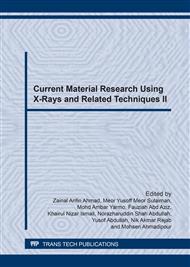[1]
W. Yang, S. Yu, S. Luo, R. Sun, W. H. Liao, C. P. Wong, A systematic study on electrical properties of the BaTiO3-epoxy composite with different sized BaTiO3 as fillers, J. Alloys Compd. 620 (2015) 315–323.
DOI: 10.1016/j.jallcom.2014.09.142
Google Scholar
[2]
G. Hu, F. Gao, J. Kong, S. Yang, Q. Zhang, Z. Liu, Y. Zhang, H. Sun, Preparation and dielectric properties of poly(vinylidene fluoride)/Ba0. 6Sr0. 4TiO3 composites, J. Alloys Compd. 619 (2015) 686–692.
DOI: 10.1016/j.jallcom.2014.09.005
Google Scholar
[3]
R. Löhnert, R. Schmidt, J. Töpfer, Effect of sintering conditions on microstructure and dielectric properties of CaCu3Ti4O12 (CCTO) ceramics, J. Electroceramics 34 (2015) 241–248.
DOI: 10.1007/s10832-015-9982-0
Google Scholar
[4]
M. A. Sulaiman, S. D. Hutagalung, J. J. Mohamed, Z. A. Ahmad, M. F. Ain, B. Ismail, High frequency response to the impedance complex properties of Nb-doped CaCu3Ti4O12 electroceramics, J. Alloys Compd. 509 (2011) 5701–5707.
DOI: 10.1016/j.jallcom.2011.02.145
Google Scholar
[5]
M. Johnsson, P. Lemmens, Crystallography and Chemistry of Perovskites, John Wiley Sons, Ltd., New York, (2007).
Google Scholar
[6]
T. Li, R. Xue, J. Hao, Y. Xue, Z. Chen, The effect of calcining temperatures on the phase purity and electric properties of CaCu3Ti4O12 ceramics, J. Alloys Compd. 509 (2011) 1025–1028.
DOI: 10.1016/j.jallcom.2010.09.163
Google Scholar
[7]
J. J. Mohamed, S. D. Hutagalung, M. F. Ain, K. Deraman, Z. A. Ahmad, Microstructure and dielectric properties of CaCu3Ti4O12 ceramic, Mater. Lett. 61 (2007) 1835–1838.
DOI: 10.1016/j.matlet.2006.07.192
Google Scholar
[8]
F. Amaral, C. P. L. Rubinger, F. Henry, L. C. Costa, M. A. Valente, A. Barros-Timmons, Dielectric properties of polystyrene-CCTO composite, J. Non. Cryst. Solids 354 (2008) 5321–5322.
DOI: 10.1016/j.jnoncrysol.2008.05.056
Google Scholar
[9]
F. Amaral, M. A. Valente, L. C. Costa, Dielectric properties of CaCu3Ti4O12 (CCTO) doped with GeO2, J. Non. Cryst. Solids 356 (2010) 822–827.
DOI: 10.1016/j.jnoncrysol.2009.07.047
Google Scholar
[10]
M. A. Sulaiman, S. D. Hutagalung, Z. A. Ahmad, M. F. Ain, Investigation of Grain Size Effect on the Impedance of CaCu3Ti4O12 from 100 Hz to 1 GHz of Frequency, Adv. Mater. Res. 620 (2013) 230–235.
DOI: 10.4028/www.scientific.net/amr.620.230
Google Scholar
[11]
M. A. Sulaiman, S. D. Hutagalung, M. F. Ain, Z. A. Ahmad, Dielectric properties of Nb-doped CaCu3Ti4O12 electroceramics measured at high frequencies, J. Alloys Compd. 493 (2010) 486–492.
DOI: 10.1016/j.jallcom.2009.12.137
Google Scholar


